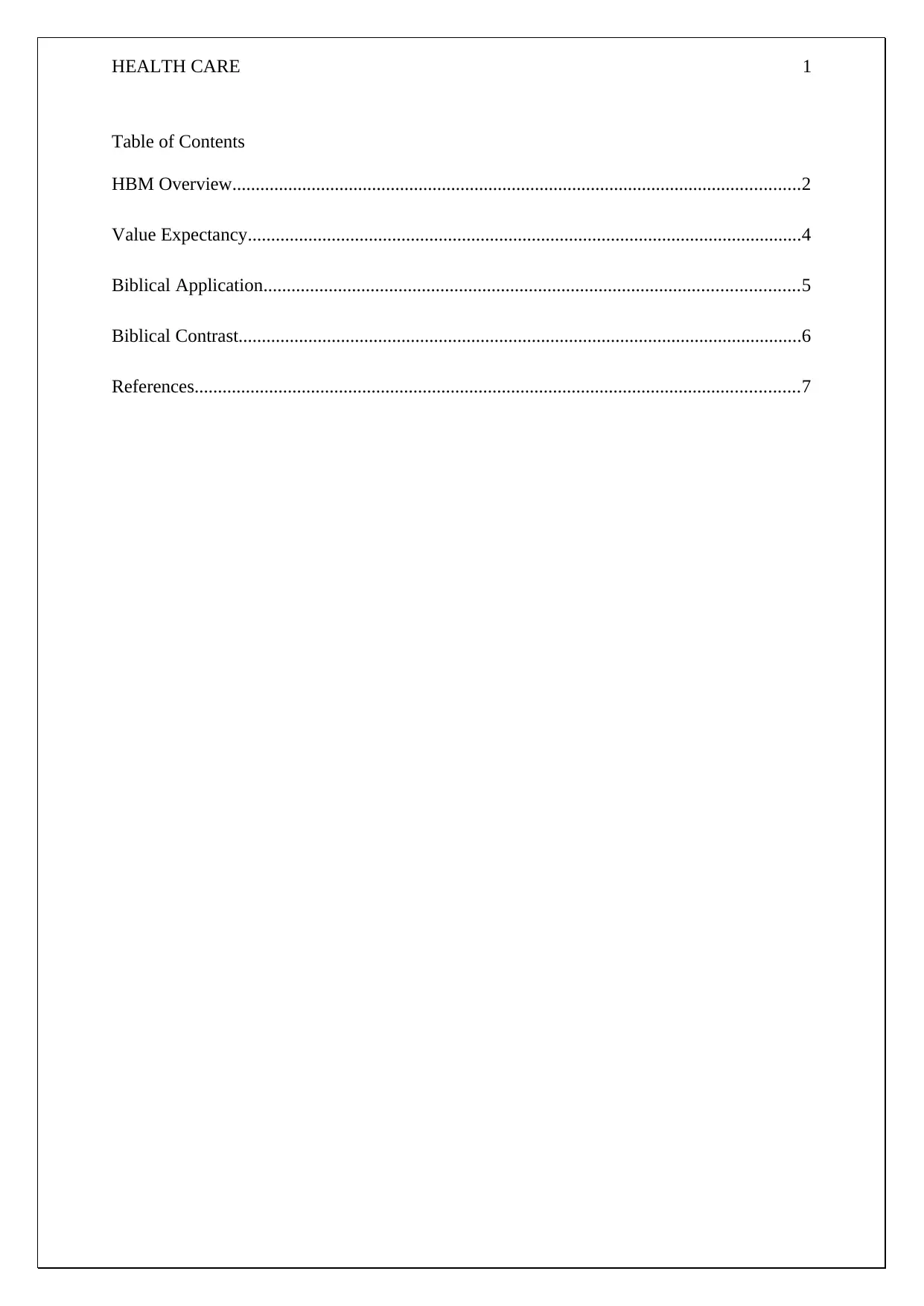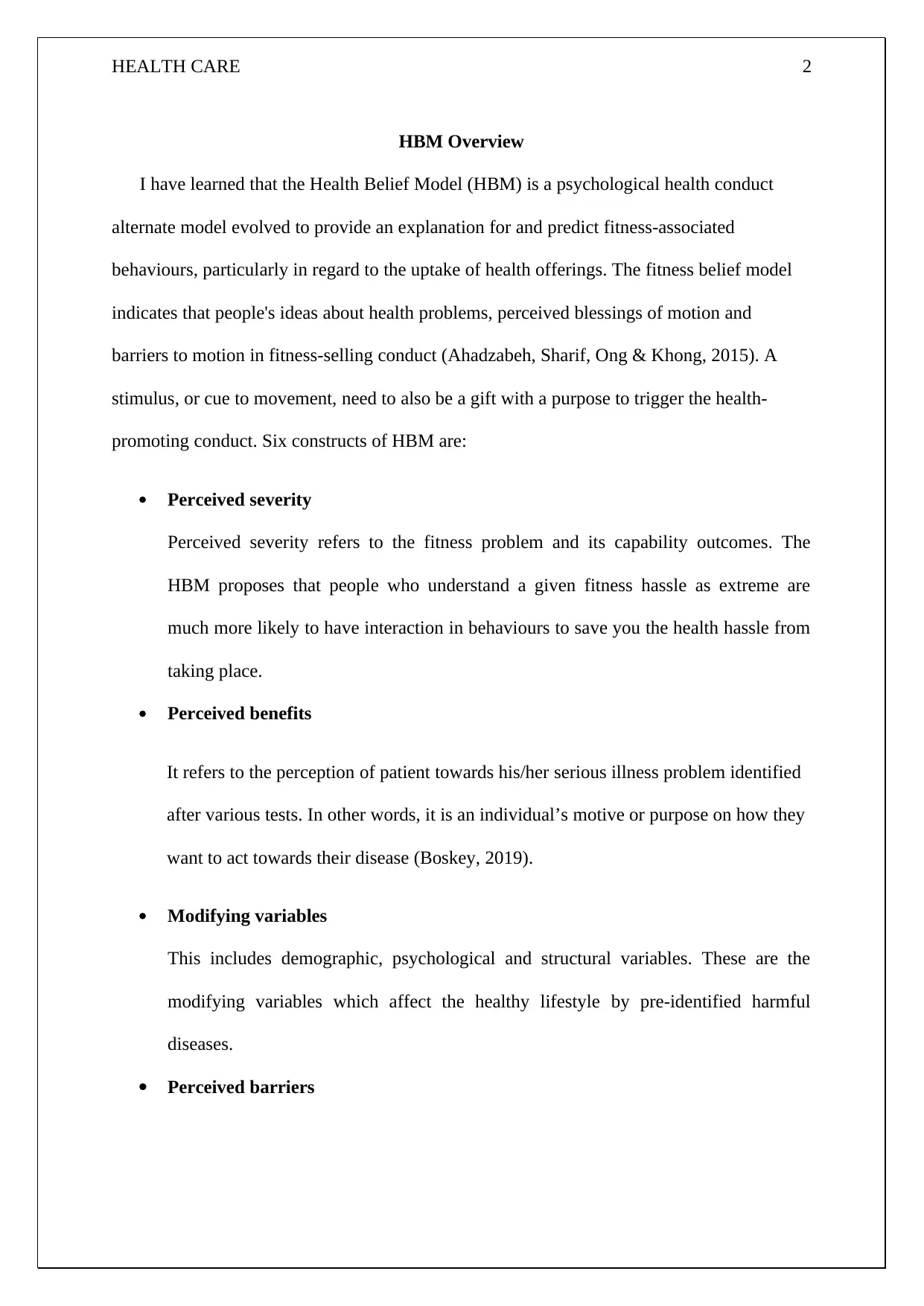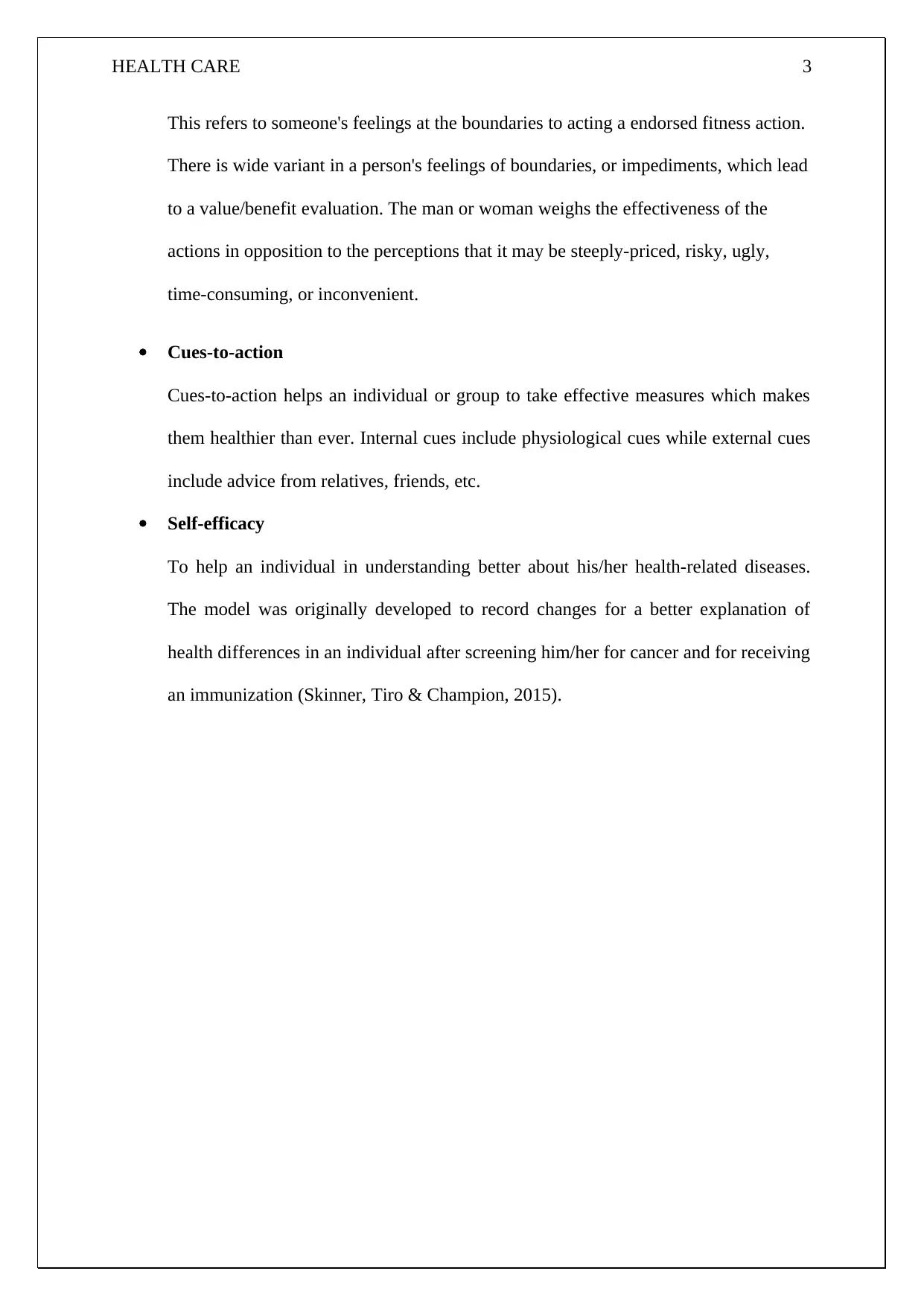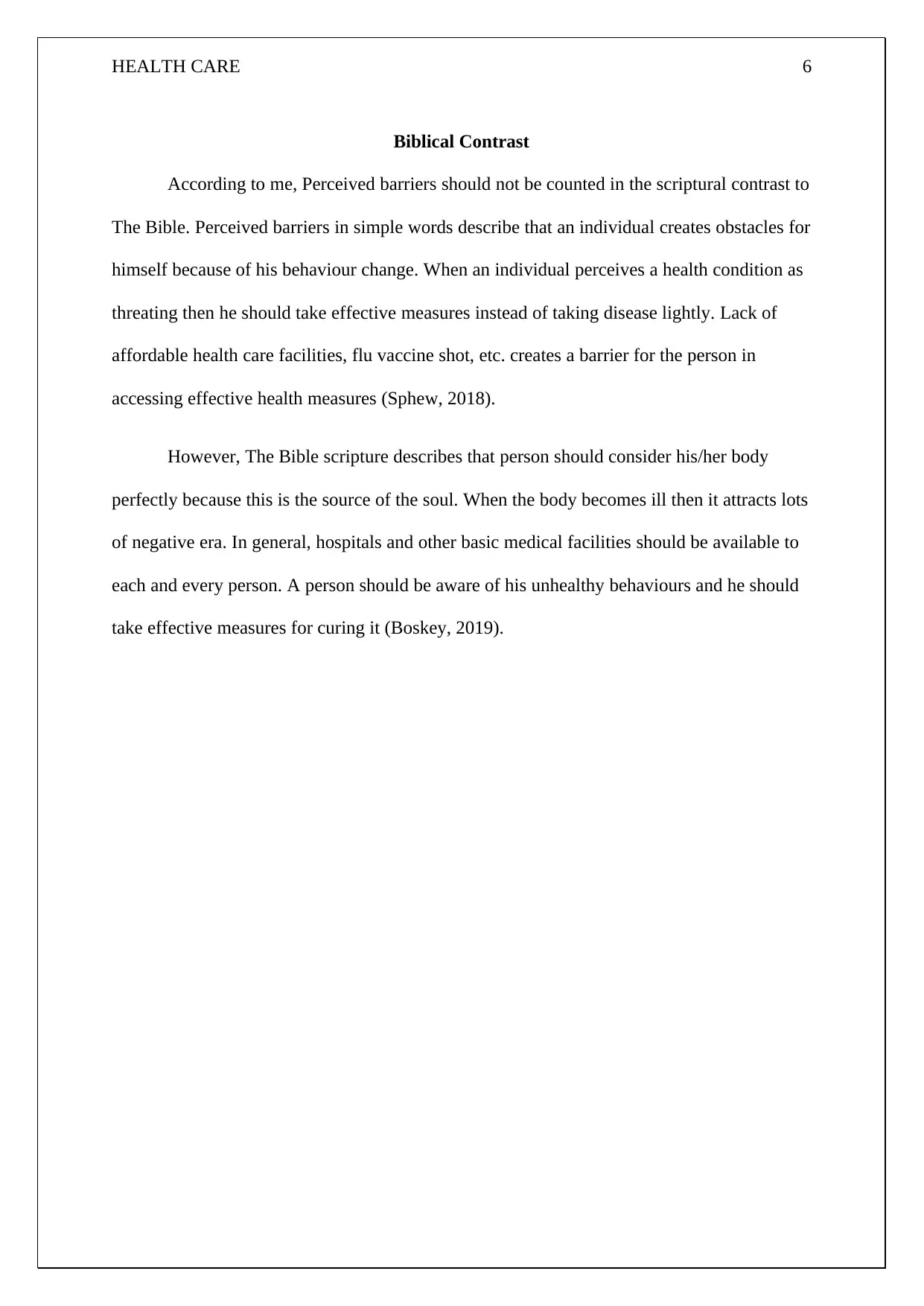Health Belief Model: Overview, Application, and Biblical Perspectives
VerifiedAdded on 2022/11/23
|8
|1134
|271
Report
AI Summary
This report provides a comprehensive overview of the Health Belief Model (HBM), a psychological health behavior change model used to explain and predict health-related behaviors. The report details the six constructs of the HBM: perceived severity, perceived benefits, modifying variables, perceived barriers, cues-to-action, and self-efficacy. It explores the HBM as a value-expectancy model, highlighting its two major factors. Furthermore, the report includes a biblical application of the HBM, focusing on the construct of "perceived benefits" and its correlation with scripture. A biblical contrast is also presented, discussing the construct of "perceived barriers" and its divergence from biblical perspectives. References to relevant literature are provided to support the analysis and understanding of the HBM.

Running Head: HEALTH CARE 0
HEALTH CARE
STUDENT DETAILS
HEALTH CARE
STUDENT DETAILS
Paraphrase This Document
Need a fresh take? Get an instant paraphrase of this document with our AI Paraphraser

HEALTH CARE 1
Table of Contents
HBM Overview..........................................................................................................................2
Value Expectancy.......................................................................................................................4
Biblical Application...................................................................................................................5
Biblical Contrast.........................................................................................................................6
References..................................................................................................................................7
Table of Contents
HBM Overview..........................................................................................................................2
Value Expectancy.......................................................................................................................4
Biblical Application...................................................................................................................5
Biblical Contrast.........................................................................................................................6
References..................................................................................................................................7

HEALTH CARE 2
HBM Overview
I have learned that the Health Belief Model (HBM) is a psychological health conduct
alternate model evolved to provide an explanation for and predict fitness-associated
behaviours, particularly in regard to the uptake of health offerings. The fitness belief model
indicates that people's ideas about health problems, perceived blessings of motion and
barriers to motion in fitness-selling conduct (Ahadzabeh, Sharif, Ong & Khong, 2015). A
stimulus, or cue to movement, need to also be a gift with a purpose to trigger the health-
promoting conduct. Six constructs of HBM are:
Perceived severity
Perceived severity refers to the fitness problem and its capability outcomes. The
HBM proposes that people who understand a given fitness hassle as extreme are
much more likely to have interaction in behaviours to save you the health hassle from
taking place.
Perceived benefits
It refers to the perception of patient towards his/her serious illness problem identified
after various tests. In other words, it is an individual’s motive or purpose on how they
want to act towards their disease (Boskey, 2019).
Modifying variables
This includes demographic, psychological and structural variables. These are the
modifying variables which affect the healthy lifestyle by pre-identified harmful
diseases.
Perceived barriers
HBM Overview
I have learned that the Health Belief Model (HBM) is a psychological health conduct
alternate model evolved to provide an explanation for and predict fitness-associated
behaviours, particularly in regard to the uptake of health offerings. The fitness belief model
indicates that people's ideas about health problems, perceived blessings of motion and
barriers to motion in fitness-selling conduct (Ahadzabeh, Sharif, Ong & Khong, 2015). A
stimulus, or cue to movement, need to also be a gift with a purpose to trigger the health-
promoting conduct. Six constructs of HBM are:
Perceived severity
Perceived severity refers to the fitness problem and its capability outcomes. The
HBM proposes that people who understand a given fitness hassle as extreme are
much more likely to have interaction in behaviours to save you the health hassle from
taking place.
Perceived benefits
It refers to the perception of patient towards his/her serious illness problem identified
after various tests. In other words, it is an individual’s motive or purpose on how they
want to act towards their disease (Boskey, 2019).
Modifying variables
This includes demographic, psychological and structural variables. These are the
modifying variables which affect the healthy lifestyle by pre-identified harmful
diseases.
Perceived barriers
⊘ This is a preview!⊘
Do you want full access?
Subscribe today to unlock all pages.

Trusted by 1+ million students worldwide

HEALTH CARE 3
This refers to someone's feelings at the boundaries to acting a endorsed fitness action.
There is wide variant in a person's feelings of boundaries, or impediments, which lead
to a value/benefit evaluation. The man or woman weighs the effectiveness of the
actions in opposition to the perceptions that it may be steeply-priced, risky, ugly,
time-consuming, or inconvenient.
Cues-to-action
Cues-to-action helps an individual or group to take effective measures which makes
them healthier than ever. Internal cues include physiological cues while external cues
include advice from relatives, friends, etc.
Self-efficacy
To help an individual in understanding better about his/her health-related diseases.
The model was originally developed to record changes for a better explanation of
health differences in an individual after screening him/her for cancer and for receiving
an immunization (Skinner, Tiro & Champion, 2015).
This refers to someone's feelings at the boundaries to acting a endorsed fitness action.
There is wide variant in a person's feelings of boundaries, or impediments, which lead
to a value/benefit evaluation. The man or woman weighs the effectiveness of the
actions in opposition to the perceptions that it may be steeply-priced, risky, ugly,
time-consuming, or inconvenient.
Cues-to-action
Cues-to-action helps an individual or group to take effective measures which makes
them healthier than ever. Internal cues include physiological cues while external cues
include advice from relatives, friends, etc.
Self-efficacy
To help an individual in understanding better about his/her health-related diseases.
The model was originally developed to record changes for a better explanation of
health differences in an individual after screening him/her for cancer and for receiving
an immunization (Skinner, Tiro & Champion, 2015).
Paraphrase This Document
Need a fresh take? Get an instant paraphrase of this document with our AI Paraphraser

HEALTH CARE 4
Value Expectancy
The Human Belief Model is considered to be a value-expectancy model because of its
six constructs. These constructs except a behaviour change and expects a certain outcome for
changing behaviour. The HBM does not advice to suggest any strategy for health-related
issues. Although it describes the changes that are more consistently associated with health
behaviours (Fuentes, 2017).
There are two major factors which can be counted in value life expectancy of The Human
Belief Model:
A person must personally feel threaten with serious or serve consequences.
A person must also believe about taking the benefits of medicines or treatment from
the certified professional. Preventive action outweighs the barriers to for diseases.
Value Expectancy
The Human Belief Model is considered to be a value-expectancy model because of its
six constructs. These constructs except a behaviour change and expects a certain outcome for
changing behaviour. The HBM does not advice to suggest any strategy for health-related
issues. Although it describes the changes that are more consistently associated with health
behaviours (Fuentes, 2017).
There are two major factors which can be counted in value life expectancy of The Human
Belief Model:
A person must personally feel threaten with serious or serve consequences.
A person must also believe about taking the benefits of medicines or treatment from
the certified professional. Preventive action outweighs the barriers to for diseases.

HEALTH CARE 5
Biblical Application
According to me from the six constructs of the Human Belief Model. “Perceived
Benefits” should be counted in scriptural support. I included this construct because this
construct related that person should immediately apply or search for the cure if he encounters
himself with any disease. There is a correlation between the scripture and perceived benefits.
The Bible entitles the person with knowledge of work and God. The Bible makes a person
skilful in engaging towards adopting various cure through knowledge and actions (Kvassav,
Krammer, Hluchy & Schneider, 2017).
Perceived benefits imply that this construct is influenced by taking action. An
individual should make an effective assessment for evaluating his or her efficacy in
promoting healthy habits or healthy activities. When an individual does that on a regular
basis then he/she become able to reduce their susceptibility about their health problem for
decreasing its seriousness. For example, someone who believes that sunscreen cream will
help him in preventing skin cancer are more likely to apply cream (sunscreen) rather than a
person who believes that sunscreen creams are useless in preventing cancer cells (Skinner,
Tiro & Champion, 2015).
According to me scripture always implies that a person should make or adopt new and
healthy routine in order to get his soul purifies. This is the correlation interlinked both
scripture and the 3rd constract of the health belief model.
Biblical Application
According to me from the six constructs of the Human Belief Model. “Perceived
Benefits” should be counted in scriptural support. I included this construct because this
construct related that person should immediately apply or search for the cure if he encounters
himself with any disease. There is a correlation between the scripture and perceived benefits.
The Bible entitles the person with knowledge of work and God. The Bible makes a person
skilful in engaging towards adopting various cure through knowledge and actions (Kvassav,
Krammer, Hluchy & Schneider, 2017).
Perceived benefits imply that this construct is influenced by taking action. An
individual should make an effective assessment for evaluating his or her efficacy in
promoting healthy habits or healthy activities. When an individual does that on a regular
basis then he/she become able to reduce their susceptibility about their health problem for
decreasing its seriousness. For example, someone who believes that sunscreen cream will
help him in preventing skin cancer are more likely to apply cream (sunscreen) rather than a
person who believes that sunscreen creams are useless in preventing cancer cells (Skinner,
Tiro & Champion, 2015).
According to me scripture always implies that a person should make or adopt new and
healthy routine in order to get his soul purifies. This is the correlation interlinked both
scripture and the 3rd constract of the health belief model.
⊘ This is a preview!⊘
Do you want full access?
Subscribe today to unlock all pages.

Trusted by 1+ million students worldwide

HEALTH CARE 6
Biblical Contrast
According to me, Perceived barriers should not be counted in the scriptural contrast to
The Bible. Perceived barriers in simple words describe that an individual creates obstacles for
himself because of his behaviour change. When an individual perceives a health condition as
threating then he should take effective measures instead of taking disease lightly. Lack of
affordable health care facilities, flu vaccine shot, etc. creates a barrier for the person in
accessing effective health measures (Sphew, 2018).
However, The Bible scripture describes that person should consider his/her body
perfectly because this is the source of the soul. When the body becomes ill then it attracts lots
of negative era. In general, hospitals and other basic medical facilities should be available to
each and every person. A person should be aware of his unhealthy behaviours and he should
take effective measures for curing it (Boskey, 2019).
Biblical Contrast
According to me, Perceived barriers should not be counted in the scriptural contrast to
The Bible. Perceived barriers in simple words describe that an individual creates obstacles for
himself because of his behaviour change. When an individual perceives a health condition as
threating then he should take effective measures instead of taking disease lightly. Lack of
affordable health care facilities, flu vaccine shot, etc. creates a barrier for the person in
accessing effective health measures (Sphew, 2018).
However, The Bible scripture describes that person should consider his/her body
perfectly because this is the source of the soul. When the body becomes ill then it attracts lots
of negative era. In general, hospitals and other basic medical facilities should be available to
each and every person. A person should be aware of his unhealthy behaviours and he should
take effective measures for curing it (Boskey, 2019).
Paraphrase This Document
Need a fresh take? Get an instant paraphrase of this document with our AI Paraphraser

HEALTH CARE 7
References
Ahadzadeh, A. S., Sharif, S. P., Ong, F. S., & Khong, K. W. (2015). Integrating health belief
model and technology acceptance model: an investigation of health-related internet
use. Journal of medical Internet research, 17(2), 34-89.
Boskey, E. (2019). Health Belief Model. Retrieved from
https://www.veryeliwellmind.com/health-belief-model-3132721
Fuentes, A. (2017). Human niche, human behaviour, human nature. Interface Focus, 7(5),
20160136.
Kvassay, M., Krammer, P., Hluchý, L., & Schneider, B. (2017). Causal analysis of an agent-
based model of human behaviour. New Jersey: Wiley
Skinner, C. S., Tiro, J., & Champion, V. L. (2015). Background on the health belief
model. California: Sage Publisher.
Sphew. (2018). The Human Belief Model. Retrieved from
http://sphweb.bumc.bu.edu/otlt/MPH-Modules/SB/BehavioralChangeTheories/
BehavioralChangeTheories2.html
References
Ahadzadeh, A. S., Sharif, S. P., Ong, F. S., & Khong, K. W. (2015). Integrating health belief
model and technology acceptance model: an investigation of health-related internet
use. Journal of medical Internet research, 17(2), 34-89.
Boskey, E. (2019). Health Belief Model. Retrieved from
https://www.veryeliwellmind.com/health-belief-model-3132721
Fuentes, A. (2017). Human niche, human behaviour, human nature. Interface Focus, 7(5),
20160136.
Kvassay, M., Krammer, P., Hluchý, L., & Schneider, B. (2017). Causal analysis of an agent-
based model of human behaviour. New Jersey: Wiley
Skinner, C. S., Tiro, J., & Champion, V. L. (2015). Background on the health belief
model. California: Sage Publisher.
Sphew. (2018). The Human Belief Model. Retrieved from
http://sphweb.bumc.bu.edu/otlt/MPH-Modules/SB/BehavioralChangeTheories/
BehavioralChangeTheories2.html
1 out of 8
Related Documents
Your All-in-One AI-Powered Toolkit for Academic Success.
+13062052269
info@desklib.com
Available 24*7 on WhatsApp / Email
![[object Object]](/_next/static/media/star-bottom.7253800d.svg)
Unlock your academic potential
Copyright © 2020–2025 A2Z Services. All Rights Reserved. Developed and managed by ZUCOL.





